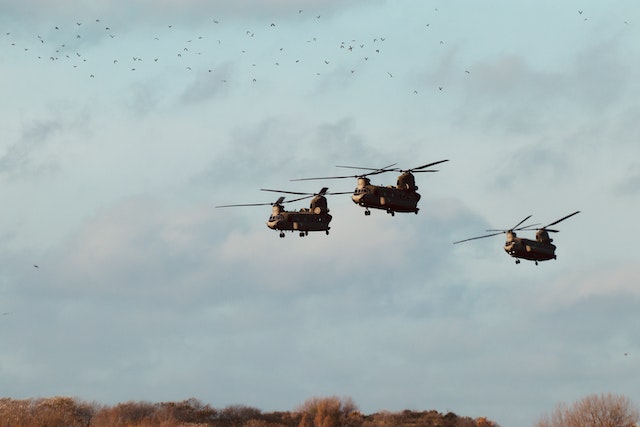
How does a helicopter with two rotors work? The rotors rotate in opposite directions and are on a transmission so that they don’t collide with each other
There are over twenty different types of helicopter that have two rotors. The Chinook is probably the most famous. It was invented in 1961, but the first tandem-rotor aircraft was built in 1927. The advantage of a tandem-rotor helicopter over a regular helicopter is that they can lift far more weight and their blades can be shorter. Tandem-rotor helicopters are not the most powerful in the world, but they are in the top 5. The Chinook can lift a cargo of about 9 tons. The most powerful helicopter is the Mil Mi-26, which can lift a cargo of 20 tons. However, the Mil Mi-26 is 10 meters longer than the Chinook and its propellors are nearly twice as long. The main rotor on the Chinook has a diameter of 18 m and the rotor on the Mil Mi-26 has a diameter of 32 m. Double rotors can give more power for the size of the helicopter and the same engine power.
So, why can a helicopter with two rotors lift more? The majority of helicopters have a single rotor on top of them. When the rotor spins, it produces torque, which makes the helicopter rotate in the opposite direction to the spinning rotors. If the rotors are spinning clockwise, the helicopter will try to spin in an anticlockwise direction. To prevent this, all helicopters with a single set of rotor blades have a tail rotor. The rotor blade provides horizontal lift, which counteracts the spin of the helicopter. If a helicopter loses its tail rotor, it will start to spin. This situation is recoverable, but it is not easy. The pilot can put the rotors on autorotation, which means they are being turned by the wind, not the engine, which reduces the torque. Or, if the pilot has enough speed, the wind flow can keep the helicopter in a straight line. However, neither of these are easy and the helicopter needs to have enough speed.
A twin-rotor helicopter doesn’t need a tail rotor because the two sets of rotor blades spin in opposite directions, counteracting the torque from each set. Because the tandem-rotor helicopter doesn’t have to use any of its engine power for the tail rotor, all of the power can go to the main rotors and it can lift more weight.
The second reason is that, even though the blades are shorter, the helicopter still has two large sets of blades, which increases the amount of lift it can produce. The second set of blades are slightly less efficient than the front set because the front set redirect a lot of the air away from the second set. Tandem-rotor helicopters have a longer center of gravity and are much more stable than regular helicopters, which can make them more useful for lifting heavy weights.
There are many advantages, but tandem-rotor helicopters need to have a very complex transmission to make sure the front and rear blades don’t hit each other. There are four blades on each set of rotors, and they are set so that the blades on the front go between the blades on the back, similar to a cog. When the engine is turned on, the power is passed to the transmission which makes both sets of rotors rotate, but they are connected to the same transmission, so they rotate at the same speed and never go out of sync. In theory, if the transmission broke, they could collide, but this is unlikely.
There are another type of helicopters that have two sets of rotor blades. These are called coaxial-rotor helicopters and they have one set of rotors above the other. They also don’t need a tail rotor because the two sets of rotors rotate in opposite directions and cancel out each other’s torque. They can carry more weight for the same engine size, and they are much more stable in flight. However, just like tandem-rotor helicopters, they are far more complex to make and the extra number of moving parts makes breakdown more likely. Some people say that coaxial-rotor helicopters are more likely to have rotor blade collisions, but the US Department of Transportation considers them to be far safer than regular helicopters. And this is what I learned today.
Photo by Adriaan Ploegh: https://www.pexels.com/photo/helicopters-in-the-sky-14577447/
https://en.wikipedia.org/wiki/Tandem-rotor_aircraft#References
https://en.wikipedia.org/wiki/Boeing_CH-47_Chinook
https://en.wikipedia.org/wiki/Mil_Mi-26
